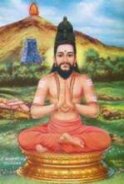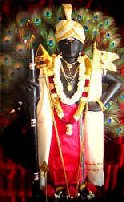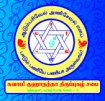

திரு அருணகிரிநாதர் அருளிய
திருப்புகழ்
Sri AruNagirinAthar's
Thiruppugazh

 |  திரு அருணகிரிநாதர் அருளிய Sri AruNagirinAthar's |  |
|---|
| திருப்புகழ் 94 மூளும்வினை சேர (திருச்செந்தூர்) Thiruppugazh 94 mULumvinaisEra (thiruchchendhUr) |
 |  | தமிழிலும் ஆங்கிலத்திலும் பொருள் எழுதியது ஸ்ரீ கோபால சுந்தரம் Meanings in Tamil and English by Sri Gopala Sundaram | English in PDF PDF அமைப்பு | ஆலய வரிசை அகரவரிசை எண்வரிசை தேடல் venue list alphabetical numerical search |
|
தானதன தான தானந்த தானந்த தானதன தான தானந்த தானந்த தானதன தான தானந்த தானந்த ...... தனதான ......... பாடல் ......... மூளும்வினை சேர மேல்கொண்டி டாஐந்து பூதவெகு வாய மாயங்கள் தானெஞ்சில் மூடிநெறி நீதி யேதுஞ்செ யாவஞ்சி ...... யதிபார மோகநினை வான போகஞ்செய் வேனண்டர் தேடஅரி தாய ஞேயங்க ளாய்நின்ற மூலபர யோக மேல்கொண் டிடாநின்ற ...... துளதாகி நாளுமதி வேக கால்கொண்டு தீமண்ட வாசியன லூடு போயொன்றி வானின்க ணாமமதி மீதி லூறுங்க லாஇன்ப ...... அமுதூறல் நாடியதன் மீது போய்நின்ற ஆநந்த மேலைவெளி யேறி நீயின்றி நானின்றி நாடியினும் வேறு தானின்றி வாழ்கின்ற ...... தொருநாளே காளவிட மூணி மாதங்கி வேதஞ்சொல் பேதைநெடு நீலி பாதங்க ளால்வந்த காலன்விழ மோது சாமுண்டி பாரம்பொ ...... டனல்வாயு காதிமுதிர் வான மேதங்கி வாழ்வஞ்சி ஆடல்விடை யேறி பாகங்கு லாமங்கை காளிநட மாடி நாளன்பர் தாம்வந்து ...... தொழுமாது வாளமுழு தாளு மோர்தண்டு ழாய்தங்கு சோதிமணி மார்ப மாலின்பி னாளின்சொல் வாழுமுமை மாத ராள்மைந்த னேயெந்தை ...... யிளையோனே மாசிலடி யார்கள் வாழ்கின்ற வூர்சென்று தேடிவிளை யாடி யேயங்ங னேநின்று வாழுமயில் வீர னேசெந்தில் வாழ்கின்ற ...... பெருமாளே. ......... சொல் விளக்கம் ......... மூளும்வினை சேர ... தீயைப் போல் மூண்டு பழைய வினைகள் ஒன்று சேர, மேல்கொண்டி டாஐந்து பூதவெகு வாய மாயங்கள் ... அதனால் உயர்ந்து எழும்பிய பஞ்ச பூதங்களின் பற்பலவிதமான மாயங்கள் தானெஞ்சில் மூடிநெறி நீதி யேதுஞ்செயா ... என் நெஞ்சில் வந்து நன்கு மூடப்பெற்று, பக்திநெறிக்குரிய அறச்செயல் ஏதும் செய்யாமல், வஞ்சி யதிபார மோகநினைவான போகஞ்செய்வேன் ... வஞ்சிக்கொடி போன்ற இடையை உடைய பெண்களின் மீதுள்ள மிகுந்த காமநினைவால் அசுத்த போகத்தை நுகர்கின்ற நான், அண்டர் தேடஅரிதாய ... தேவர்களும் தேடித் தெரிந்துகொள்வதற்கு அரிய பொருளாகிய, ஞேயங்களாய்நின்ற ... மெய்யுணர்வினால் ஆராய்ந்து அறியப்படுகின்றவையாக விளங்கும் மூலபர யோக மேல்கொண் டிடாநின்ற அது உளதாகி ... முதன்மையான அனுபவ யோகத்திலே முனைந்து நின்று, அதனிடத்திலேயே அசைவற்று இருப்பதாகி, நாளும் அதி வேக கால்கொண்டு ... நாள்தோறும் வெகு வேகமாக எழும் பிராணவாயுவைக் கொண்டு, தீமண்ட வாசியன லூடு போயொன்றி ... மூலக்கனல்* மண்டி எழுந்திருக்க, பிராணவாயுவானது அந்த அக்கினியில் சென்று பொருந்த, வானின்கண் நாமமதி மீதி லூறுங்கலாஇன்ப அமுதூறல் நாடி ... ஆகாயத்தில் புகழ்பெற்ற சந்திரனிலிருந்து பொழியும் அமிர்தகலை என்னும் இனிய அமுதப் பொழிவை நாடி, அதன் மீது போய் நின்ற ஆநந்த மேலைவெளி யேறி ... அச்சந்திர மண்டலத்தில் சென்று, நிலைத்த ஆநந்தப் பெருவெளியில் மீது ஏறி அமர்ந்து, நீயின்றி நானின்றி நாடி ... நீ நான் என்ற பிரிவற்ற அத்வைத முக்தியை உணர்ந்து, இனும் வேறு தானின்றி வாழ்கின்ற தொருநாளே ... இன்னும் பிற பொருள்களும் தோன்றாத மனம் நீங்கிய சுக வாழ்வில் வாழ்கின்ற ஒருநாள் எனக்கு உண்டாகுமோ? காளவிட மூணி ... அவள் (பாற்கடலில் தோன்றிய) ஆலகால விஷத்தை அருந்தியவள், மாதங்கி வேதஞ்சொல் பேதை ... மதங்க முநிவருக்குப் பெண்ணாக அவதரித்தவள், வேதங்களால் புகழப் பெறுபவள், நெடு நீலி ... பெரும் தகைமையை உடைய துர்க்கை, பாதங்களால்வந்த காலன்விழ மோது சாமுண்டி ... (மார்க்கண்டேயனின் உயிரைப் பறிக்க) வந்த யமன் இறந்து விழுமாறு திருவடிகளால் உதைத்து வீழ்த்திய காளியம்மை, பார் அம்பொடு அனல்வாயு காதிமுதிர் வானமே தங்கி வாழ்வஞ்சி ... பூமி, நீர், தீ, வாயு, பேரொளி மிகுந்த வானம் ஆகிய பஞ்ச பூதங்களிலும் தங்கி அந்தர்யாமியாக விளங்கும் கொடியைப் போன்றவள், ஆடல்விடை யேறி பாகங்குலாமங்கை ... ஆநந்த நடனம் ஆடுபவரும், ரிஷப வாகனமாம் நந்திமேல் ஏறுபவருமான சிவபிரானின் இடப்பாகத்தில் இன்பமுடன் குலவி அமரும் மங்கை, காளிநட மாடி ... பத்ரகாளியாக நின்று சிவதாண்டவத்துக்கு எதிர்த்தாண்டவம் செய்தவள், நாளன்பர் தாம்வந்து தொழுமாது ... நாள்தோறும் மெய்யடியார்கள் அவளது சன்னிதிக்கு வந்து வழிபட்டு வணங்கப் பெறும் தாயார், வாளமுழு தாளும் ஓர்தண் துழாய்தங்கு ... சக்ரவாளகிரியால் சூழப்பட்ட இந்த உலகம் முழுதையும் ஆள்கின்ற, குளிர்ந்த துளசிமாலையை அணிந்த, சோதிமணி மார்ப மாலின் பி(ன்)னாள் ... ஒளிமயமான ரத்தின மாலையை அணிந்த மார்பினனான, திருமாலின் தங்கை, இன்சொல் வாழுமுமை மாதராள் மைந்தனே ... இனிமையான சொற்களை உடையவளான மாதரசி பார்வதி தேவியின் மைந்தனே, எந்தை யிளையோனே ... எமது பிதாவாகிய சிவபிரானின் இளைய புதல்வனே, மாசிலடி யார்கள் வாழ்கின்ற வூர்சென்று ... குற்றமற்ற மெய்யடியார்கள் வாழ்கின்ற ஊர்களை நாடிச்சென்று, தேடிவிளை யாடி யேயங்ங னேநின்று வாழுமயில் வீரனே ... அவர்களைத் தேடி, பல திருவிளையாடல்களைப் புரிந்து, அத்தலங்களிலேயே நிரந்தரமாகத் தங்கும் மயில் வீரனே, செந்தில் வாழ்கின்ற பெருமாளே. ... திருச்செந்தூர்ப் பதியில் எழுந்தருளியுள்ள பெருமாளே. |
* இங்கு சிவயோக முறைகள் விளக்கப்பட்டுள்ளன. அதன் சுருக்கம் வருமாறு: நாம் உள்ளுக்கு இழுக்கும் காற்றுக்குப் 'பூரகம்' என்றும், வெளிவிடும் காற்றுக்கு 'ரேசகம்' என்றும் பெயர். உள்ளே நிறுத்திவைக்கப்படும் காற்றுக்கு 'கும்பகம்' என்று பெயர். உட் கொள்ளும் பிராணவாயு உடலில் குறிப்பிட்ட 'ஆதாரங்கள்' (நிலைகள், சக்கரங்கள்) மூலமாகப் படிப்படியாகப் பரவி, மேல் நோக்கிச் சென்று, தலையில் 'பிரம கபால'த்தில் உள்ள 'ஸஹஸ்ராரம்' (பிந்து சக்கரம்) என்ற சக்கரத்துக்குச் செல்லும். இந்த ஐக்கியம் ஏற்படும்போது, அமுத சக்தி பிறந்து, ஆறு ஆதாரங்களுக்கும் ஊட்டப்பட்டு, மீண்டும் அதே வழியில் 'மூலாதார'த்தை வந்து அடையும். இந்த ஆதாரங்களை ஒழுங்கு படுத்தும் வகையில் மூன்று 'மண்டல'ங்களும் (அக்கினி, ஆதித்த, சந்திர மண்டலங்கள்), பத்து 'நாடி'களும் (இடைகலை, பிங்கலை, சுழுமுனை முதலியன) உள்ளன. 'இடைகலை' பத்து நாடிகளுள் ஒன்று. இடது நாசியால் விடும் சுவாசம். 'பிங்கலை' பத்து நாடிகளுள் ஒன்று. வலது நாசி வழியால் விடும் சுவாசம். 'சுழு முனை' இடைகலைக்கும் பிங்கலைக்கும் இடையில் உள்ளது. 'சுழு முனை' ஆதாரம் ஆறிலும் ஊடுருவி நிற்பது. 'இடைகலை'யும், 'பிங்கலை'யும் ஒன்றுக்கொன்று பின்னி நிற்பன. சுவாச நடப்பை 'ப்ராணாயாமம்' என்ற யோக வன்மையால் கட்டுப்படுத்தினால் மன அமைதி ஏற்படும். |
ஆதாரங்களின் பெயர்களும், உடலில் இருக்கும் இடம், உரிய ஐம்பூதங்கள், அனுட்டிக்கும்போது மலர் வடிவங்களின் அமைப்பு, அக்ஷரக் குறிப்பு ஆகியவை கீழே தரப்பட்டுள்ளன. மேலும் இந்த ஆதாரங்களுக்கு உரிய தலங்கள், கடவுளர்கள் பெயர்களும் கொடுக்கப்பட்டுள்ளன. | ||||||
| ஆதாரம் மூலாதாரம் சுவாதிஷ்டானம் மணிபூரகம் அநாகதம் விசுத்தி ஆக்ஞா பிந்து சக்கரம் (துவாதசாந்தம், ஸஹஸ்ராரம், பிரமரந்திரம்) | இடம் குதம் கொப்பூழ் மேல்வயிறு இருதயம் கண்டம் புருவத்தின் நடு கபாலத்தின் மேலே | பூதம் மண் அக்கினி நீர் காற்று ஆகாயம் மனம் | வடிவம் 4 இதழ் கமலம் முக்கோணம் 6 இதழ் கமலம் லிங்கபீடம் நாற் சதுரம் 10 இதழ் கமலம் பெட்டிப்பாம்பு நடு வட்டம் 12 இதழ் கமலம் முக்கோணம் கமல வட்டம் 16 இதழ் கமலம் ஆறு கோணம் நடு வட்டம் 3 இதழ் கமலம் 1008 இதழ் கமலம் | அக்ஷரம் ஓம் ந(கரம்) ம(கரம்) சி(கரம்) வ(கரம்) ய(கரம்) | தலம் திருவாரூர் திருவானைக்கா திரு(வ) அண்ணாமலை சிதம்பரம் திருக்காளத்தி காசி (வாரணாசி) திருக்கயிலை | கடவுள் விநாயகர் பிரமன் திருமால் ருத்திரன் மகேசுரன் சதாசிவன் சிவ . சக்தி ஐக்கியம் |
| 'wikisource' reference links for this song இப்பாடலுக்கான 'விக்கிமூலம்' இணையப் பக்கங்கள் pg 1.234 pg 1.235 pg 1.236 pg 1.237 WIKI_urai Song number: 93 goto wiki alpha list (Please note: Kaumaram.com is NOT responsible for accuracy and contents of external links) |
 | 'குருஜி' ராகவன் அவர்களுடன் திருப்புகழ் அன்பர்கள் 'Guruji' Ragavan and Thiruppugazh Anbargal பாடகர் பக்கத்திற்கு to singer's page |
|
 | ஸ்ரீ மஹா பெரியவா திருப்புகழ் சபை & சுவாமி குஹாநந்தா திருப்புகழ் சபை (சேலம்) Sri Maha Periyava Thirupugazh Sabha & Swamy Gughanandha Thirupugazh Sabha (Salem) |  பாடகர் பக்கத்திற்கு பாடகர் பக்கத்திற்கு to singer's page |
 | சுவாமி குஹாநந்தா திருப்புகழ் சபை (சேலம்) இப்பாடலின் பொருள் Swamy Gughanandha Thirupugazh Sabha (Salem) meanings in Tamil |  |
|
Song 94 - mULumvinai sEra (thiruchchendhUr) mULumvinai sEra mElkoNdi dAainthu pUthaveku vAya mAyangkaL thAnenjil mUdineRi neethi yEthunce yAvanji ...... yathipAra mOkaninai vAna pOkansey vEnaNdar thEdaari thAya njEyanga LAyninRa mUlapara yOka mElkoNdi dAninRa ...... thuLathAki nALumathi vEka kAlkoNdu theemaNda vAsiyana lUdu pOyonRi vAninka NAmamathi meethi lURunka lAinpa ...... amuthURal nAdiyathan meethu pOyninRa Anantha mElaiveLi yERi neeyinRi nAninRi nAdiyinum vERu thAninRi vAzhkinRa ...... thorunALE kALavida mUNi mAthangi vEthancol pEthainedu neeli pAthanga LAlvantha kAlanvizha mOthu sAmuNdi pArampo ...... danalvAyu kAthimuthir vAna mEthangi vAzhvanji Adalvidai yERi pAkangku lAmangai kALinada mAdi nALanpar thAmvanthu ...... thozhumAthu vALamuzhu thALu mOrthaNthu zhAythangu sOthimaNi mArpa mAlinpi nALinsol vAzhumumai mAtha rALmaintha nEyenthai ...... yiLaiyOnE mAsiladi yArkaL vAzhkinRa vUrsenRu thEdiviLai yAdi yEyangnga nEninRu vAzhumayil veera nEsenthil vAzhkinRa ...... perumALE. ......... Meaning ......... mULumvinai sEra: All my old deeds ignited together; mElkoNdi dAainthu pUthaveku vAya mAyangaL thAnenjil mUdi: because of that, all the five elements leapt high, creating delusions and shutting down my heart; neRi neethi yEthunceyA: I could not perform any righteous or religious act; vanji yathipAra mOkaninaivAna pOkanseyvEn: and my thoughts were lustful, hankering after the vanji (rattan reed) creeper-like slender waists of women. aNdar thEda arithAya njEyangaLAyninRa: It is something which is beyond the reach of even the celestials and It can be perceived only through researches of inner feelings; mUlapara yOka mElkoN didAninRa athu uLathAki: It prevails within, and is situated without any movement in, the supreme experience of yOgA; nALum athi vEka kAlkoNdu: It travels everyday speedily through the inhaled air (oxygen) theemaNda vAsiyana lUdu pOyonRi: which mingles with the vital fire (agni)* that springs up (from the stomach); vAninkaN nAmamathi meethi lURunkalAinpa amuthURal nAdi: It seeks the sweet nectar oozing from the celebrated moon in the sky; athan meethu pOy ninRa Anantha mElaiveLi yERi: then It climbs up to the world of the moon and settles at the great blissful cosmos; neeyinRi nAninRi nAdi: It reaches a state of Oneness (advaita) where there is no distinction between You and me; inum vERu thAninRi vAzhkinRa thorunALE: also there is nothing else in my mind which becomes extinct; will there be a day when I shall experience that bliss? kALavida mUNi: She imbibed the primary poison (that emerged from the milky ocean); mAthangi vEthancol pEthai: She incarnated as the daughter of Sage Mathanga; She is the One praised by the VEdAs; nedu neeli: She is the Great Durga Devi; pAthangaLAlvantha kAlanvizha mOthu sAmuNdi: (When Yaman, the God of Death, came to grab the life of MArkaNdEyA,) She, as KALi, kicked Yaman to death with Her hallowed feet; pAr ampodu analvAyu kAthimuthir vAnamE thangi vAzhvanji: She resides latently as a tender vanji (rattan reed) within, and transcends, all the five elements (namely, Earth, Water, Fire, Air and the Sky); Adalvidai yERi pAkangkulAmangai: She is concorporate with relish the left side of Lord SivA who is the Great Cosmic Dancer and who mounts the bull, Nandi; kALinada mAdi: As Bhadra KALi, She challenges and dances ferociously in competition with SivA's Dance; nALanpar thAmvanthu thozhumAthu: She is the Divine Mother worshipped everyday by Her devotees coming to Her shrine; vALamuzhu thALum OrthaN thuzhAythangu: He rules the entire universe surrounded by Mount ChakravALa and wears the cool garland made of ThuLasi; sOthimaNi mArpa mAlin pi(n)nAL: He also adorns His chest with a dazzling necklace of precious gems; He is Lord Vishnu, and She is His sister; insol vAzhumumai mAtharALmainthanE: She is the sweetest tongued one, and She is Mother UmAdEvi. You are Her dear son! enthai yiLaiyOnE: You are the younger son of our Father, Lord SivA! mAsiladi yArkaL vAzhkinRa vUrsenRu: You follow Your unblemished devotees by going to their towns, thEdiviLai yAdi yEyangnga nEninRu vAzhumayil veeranE: and seek them out to play several of your pranks with them and reside permanently in their places, Oh Warrior mounting the Peacock! senthil vAzhkinRa perumALE.: Your abode is ThiruchchendhUr, Oh Great One! |
* In this song, several Siva-yOgA principles are explained: The inhaled air is known as 'pUragam' and the exhaled air is 'rechagam'. The retained air is 'kumbagam'. The oxygen that enters the body climbs up step by step through several centres, known as 'chakrAs' and ultimately reaches 'sahasrAram' or 'bindhuchakram' on the top of the skull. At that point of union, nectar flows from that chakrA and seeps through and soaks the six centres of the body and returns to the basic chakrA, 'mUlAthAram'. Three zones (namely, the sun zone, the moon zone and the fire zone) and ten nerves ('nAdis') govern the six centres; the principal nerves are 'susumna', 'idaikala' and 'pingala'. idakala: one of the ten 'nAdis' (nerves), when inhalation takes place through the left nostril; pingala: one of the ten 'nAdis' (nerves), when inhalation takes place through the right nostril; susumna: one of the ten 'nAdis' (nerves), situated between the above two 'nadis', and running through the spinal chord covering all the six centres of 'kundalini'. ('idakala' and 'pingala' are entwined around 'susumna'). If breathing is controlled through a yOgA called 'praNAyAmA', the mind becomes tranquil. |
The names of the chakrA centres, the deities, the elements, the zones of the body where they are located, the shape of the chakrAs, the description of the flowers in the chakrAs, the letters of the ManthrA governing them and the temple-towns representing them are given in the following chart: | ||||||
| ChakrA mUlAthAram swAthishtAnam maNipUragam anAgatham visudhdhi AgnyA Bindu chakkaram (DhwAdhasAntham, SahasrAram, Brahma-ranthiram) | Body Zone Genitals Belly-button Upper belly Heart Throat Between the eyebrows Over the skull | Element Earth Fire Water Air Sky Mind | Shape 4-petal lotus Triangle 6-petal lotus Lingam Square 10-petal lotus cobra in box central circle 12-petal lotus Triangle lotus circle 16-petal lotus Hexagon central circle 3-petal lotus 1008-petal lotus | Letter Om na ma si va ya | Temple ThiruvArUr ThiruvAnaikkA Thiru aNNAmalai Chidhambaram ThirukkALaththi VaranAsi (kAsi) Mt. KailAsh | Deity VinAyagar BrahmA Vishnu RUdhran MahEswaran SathAsivan Siva-Sakthi Union |
| தமிழில் PDF அமைப்பு ஆலய வரிசை அகரவரிசை எண்வரிசை தேடல் in PDF venue list alphabetical numerical search |
| ... www.kaumaram.com ... The website for Lord Murugan and His Devotees முகப்பு அட்டவணை மேலே தேடல் home contents top search |
If you do not see Tamil characters or for 'offline' viewing, please install 'SaiIndira' fonts from Azhagi.com download Free Azhagi software |
Kaumaram.com is a non-commercial website. This website is a dedication of Love for Lord Murugan. Please take note that Kaumaram.com DOES NOT solicit any funding, DIRECTLY or INDIRECTLY. |